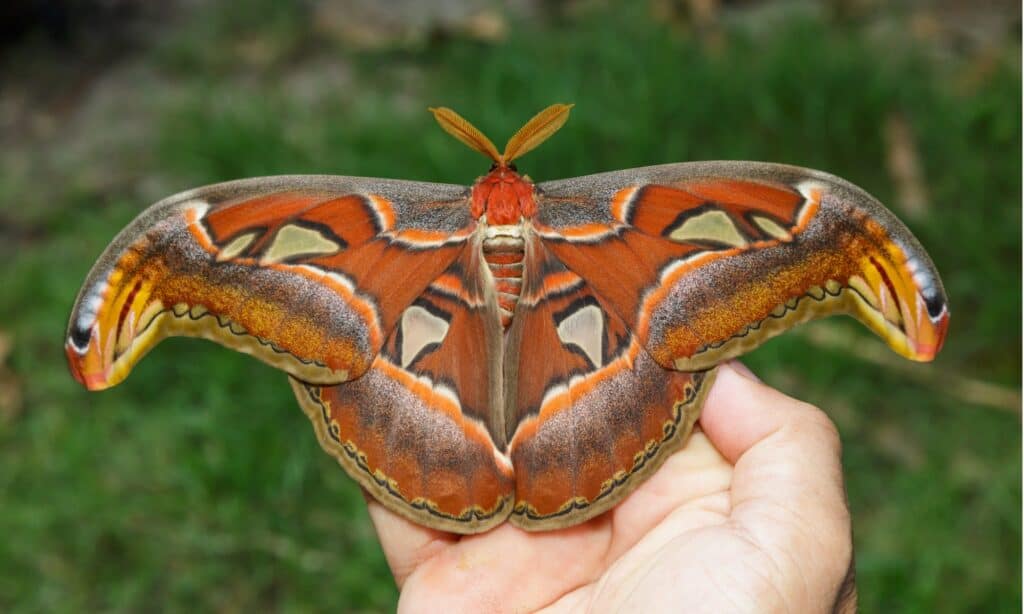Atlas Moth
Attacus atlas
Adult atlas moths do not eat - they live off fat they stored as larvae.
Advertisement
Atlas Moth Scientific Classification
- Kingdom
- Animalia
- Phylum
- Arthropoda
- Class
- Insecta
- Order
- Lepidoptera
- Family
- Saturniidae
- Genus
- Attacus
- Scientific Name
- Attacus atlas
Read our Complete Guide to Classification of Animals.
Atlas Moth Conservation Status
Atlas Moth Facts
- Name Of Young
- Larva
- Group Behavior
- Solitary
- Fun Fact
- Adult atlas moths do not eat - they live off fat they stored as larvae.
- Biggest Threat
- Birds and lizards
- Most Distinctive Feature
- Large wings with distinctive brown and white markings
- Other Name(s)
- Attacus Atlas
- Gestation Period
- 4 Weeks (in the pupal stage)
- Wingspan
- Up to 10 inches
- Habitat
- Dry tropical forests, shrubland, and secondary forests in Southeast Asia
- Predators
- Birds and lizards
- Diet
- Herbivore
- Average Litter Size
- 200-300
- Favorite Food
- Citrus, evergreen, cinnamon, and guava trees
- Type
- Insect
- Common Name
- Atlas moth
- Number Of Species
- 1
- Location
- Southeast Asia
- Group
- Solitary
Atlas Moth Physical Characteristics
- Color
- Brown
- Yellow
- Red
- Black
- Purple
- Skin Type
- Exoskeleton
- Lifespan
- 1-2 Weeks
- Age of Sexual Maturity
- 60-90 minutes after leaving the pupal stage
- Venomous
- No
- Aggression
- Low
View all of the Atlas Moth images!
The atlas moth is a beautiful insect found mainly in Southeast Asia.
It is known for its short lifespan, large wingspan, and unique brown and white markings.
Unique Atlas Moth Facts
- Atlas moth markings and wing shape may resemble a snake to potential predators, especially when they are flying.
- The Cantonese name for the atlas moth means ”snake’s head moth.”
- Atlas moths mainly fly at night to conserve energy.
- Female Atlas moths tend to stay in one place to attract a mate. Males fly to the females.
- The Atlas moth is the second largest moth species in the world.
Atlas Moth Species, Types, and Scientific Name
The scientific name of the atlas moth is Attacus atlas. The name atlas may represent the map-like features of the wing design and its large size. Atlas was one of the Titans—giant mythical beings from Greek mythology.
It is in the genus Attacus, which includes other large moths like Attacus caesar. The family Saturniidae is made up of over 2,000 special moths, including the Atlas moth. This family includes the small emperor moth with its distinctive eye-like wing pattern.
Appearance: How To Identify Atlas Moths
Atlas moths can best be identified by their distinctive wing markings. The top outer edge of each wing has a point that sticks out which looks similar to a snake’s head. The rest of the wing has a pattern of a reddish-brown background, white, purple, and brown stripes, towards the outer edge of the wing, and white triangles in the middle of the wing.
Experts believe that the snake-like markings are designed to put off predators who may think the atlas moth is a tasty treat.
Male Atlas moths are smaller than females. Their bodies range in length from 30 to 36 millimeters and their wingspan is between 210 and 230 millimeters. Larger females have a body length of 39 to 40 millimeters and a wingspan of 240 to 250 millimeters. Keep in mind, that 250 millimeters is nearly 10 inches! Now you see why they named this moth after a Titan of Greek mythology.
The atlas moth is second in wingspan size only to the white witch moth which has a wingspan of 14 inches. However, there are several other moth species that have an average wingspan around the same size as an atlas.
Atlas moths only live for a few days to a few weeks. Once they mate, they die. However, before they are moths, they have other life cycle stages such as eggs, larvae, and a pupa.
Atlas moth eggs are white or pale yellow, oval-shaped and flattish. You will find them on the underside of leaves that larvae feed on, including citrus cinnamon, guava, and evergreen trees. Female Atlas moths can lay up to 300 eggs at one time!
The eggs are sticky so they can stick to the leaf or to each other. They are just a few millimeters in both width and length. The eggs hatch after about two weeks and the larvae are born.
Atlas moth larvae are small green caterpillars with brown specks. They are about 4.5 inches long. They have a distinctive orange ring on their rear end. The larvae eat their eggshell, then eat leaves until they are ready to make their cocoon.
After four weeks of eating, they spin a cocoon of silk mixed with leaves and emerge as the atlas moth another four weeks later. The moths live most of their lives in one single tree!

©iStock.com/Mathisa_s
Habitat: Where to Find the Atlas Moth
Atlas moths mainly live in tropical forests in Asia. They are commonly found in southeast China, Hong Kong, India, Nepal, Taiwan, and Cambodia, as well as other Asian countries.
The atlas moth habitat consists of a wet season and a dry season. They prefer temperatures in the upper 70s.
Diet: What Do Atlas Moths Eat?
Technically, Atlas moths eat nothing! Atlas moths do not have the usual proboscis moths use to drink nectar from flowers. Theirs is too short to allow them to eat anything. They live off of fat they stored as larvae. They only live from 7-14 days in the moth stage.
Male atlas moths primarily fly at night to avoid flying in the warmest and most taxing time of day to conserve their energy, since they have no way to refuel. Female atlas moths typically stay in place while trying to attract a mate and do not fly much in general.
Atlas Moth and Humans
In some countries, hobbyists and craftspeople use atlas moth silk to make lampshades, shoes, purses, and clothing. However, it is not used on a large scale commercially because the silk comes out in short strands, not long ones like the traditional silkmoth. The silk is also thicker and more wool-like.
The silk made from atlas moths is called fagara. It ranges in color from brown to tan. Some countries, like Indonesia, export fagara to Japan to be made into obi—thick belts worn with kimonos.
Some experts believe that atlas moth silk could have more commercial uses in the future since it is more durable than traditional silk.
In Thailand, people sometimes use atlas moth cocoons as a change purse or a pouch to hold other objects.
Sources:
https://mississippientomologicalmuseum.org.msstate.edu/AnthroEnt/Textiles/Species/Attacus_Atlas_.html
Atlas Moth FAQs (Frequently Asked Questions)
What is the point of the Atlas Moth?
Once they hatch from their cocoon, the whole life purpose of an atlas moth is to find a mate. Once they mate, they die.
Are Atlas Moths in Australia?
Yes, atlas moths are found on the northwestern tip of the Northwestern Territory in Australia.
Why Does the Atlas Moth Look Like a Snake?
When the atlas moth is threatened, it will move its wings in such a way to make itself look more snake-like to scare away a predator.
How Many Eggs Does the Atlas Moth Lay?
A female atlas moth can lay between 200 and 300 eggs.
Thank you for reading! Have some feedback for us? Contact the AZ Animals editorial team.
Sources
- Animal Diversity Web / Accessed May 12, 2022
- Wikipedia / Accessed May 12, 2022
- Treehugger / Accessed May 12, 2022
- Wikipedia / Accessed May 12, 2022
- NC State / Accessed May 12, 2022
- Mississippi State University / Accessed May 12, 2022















